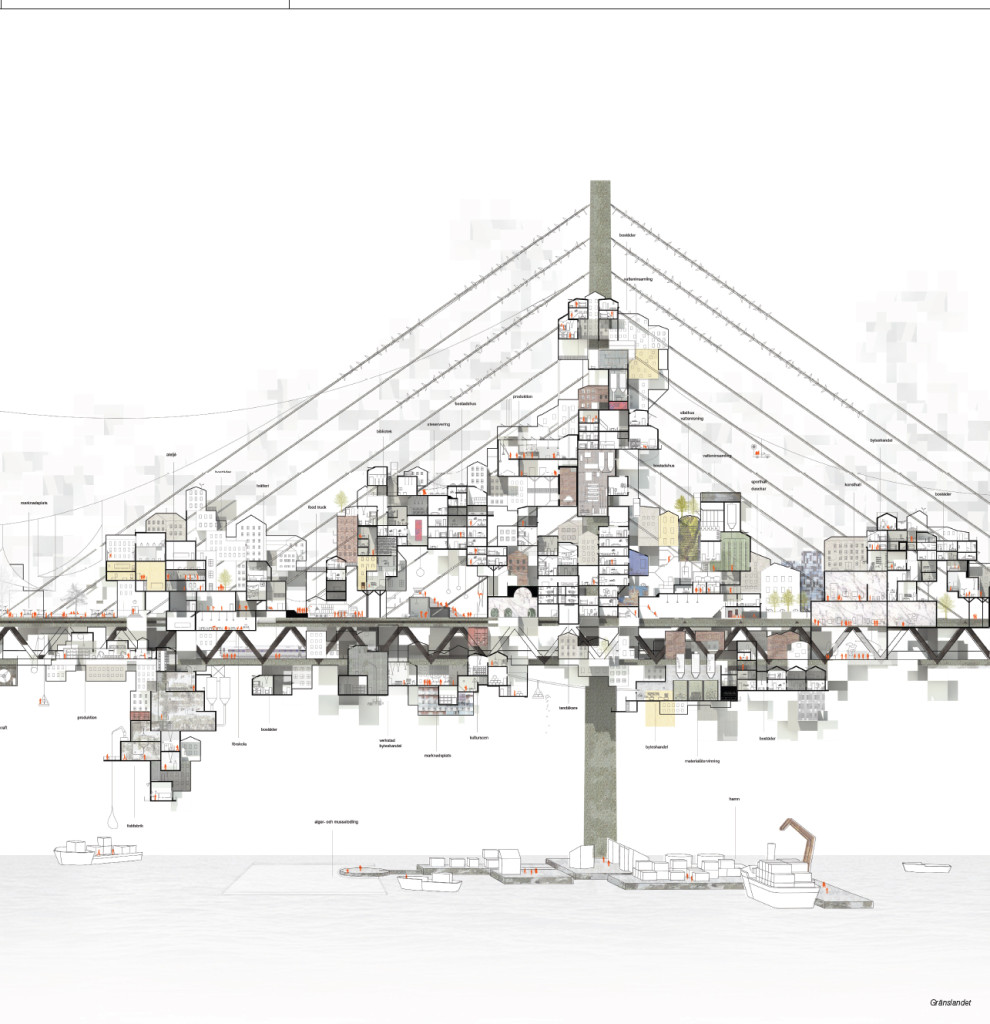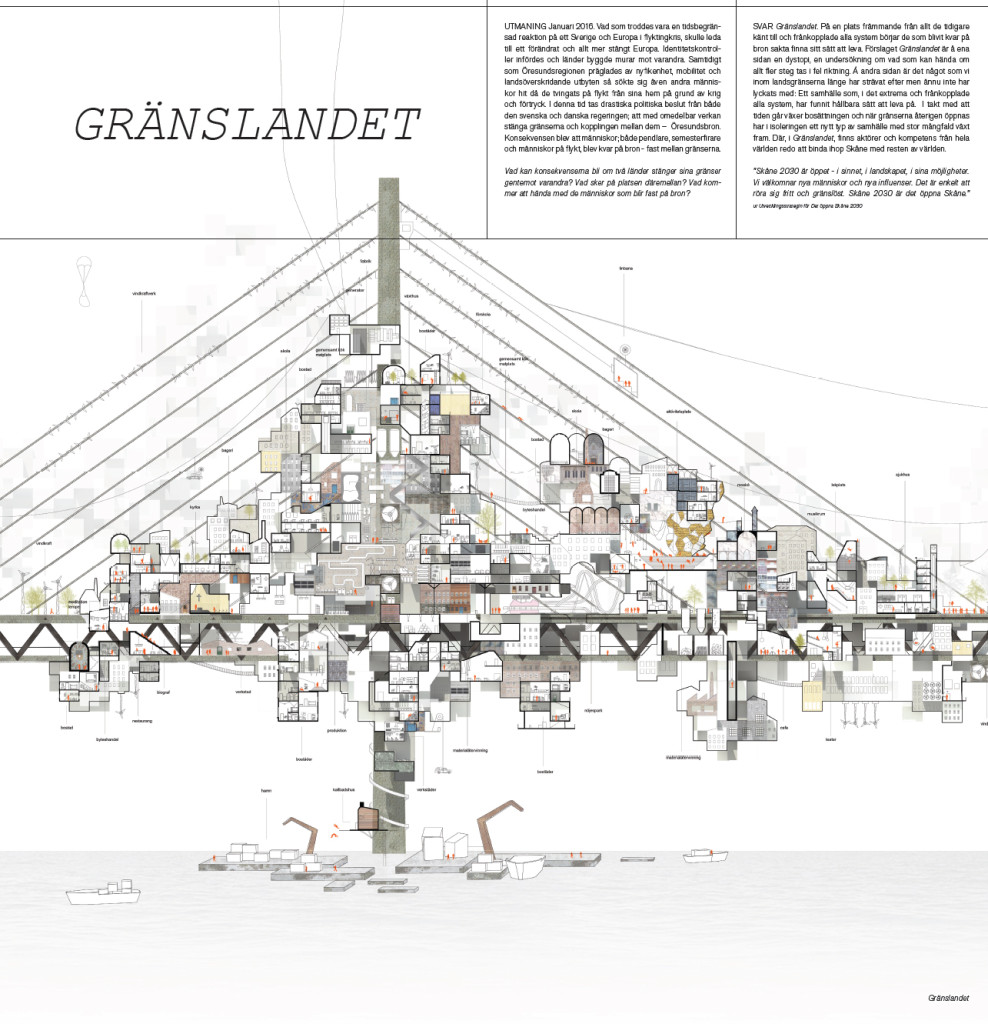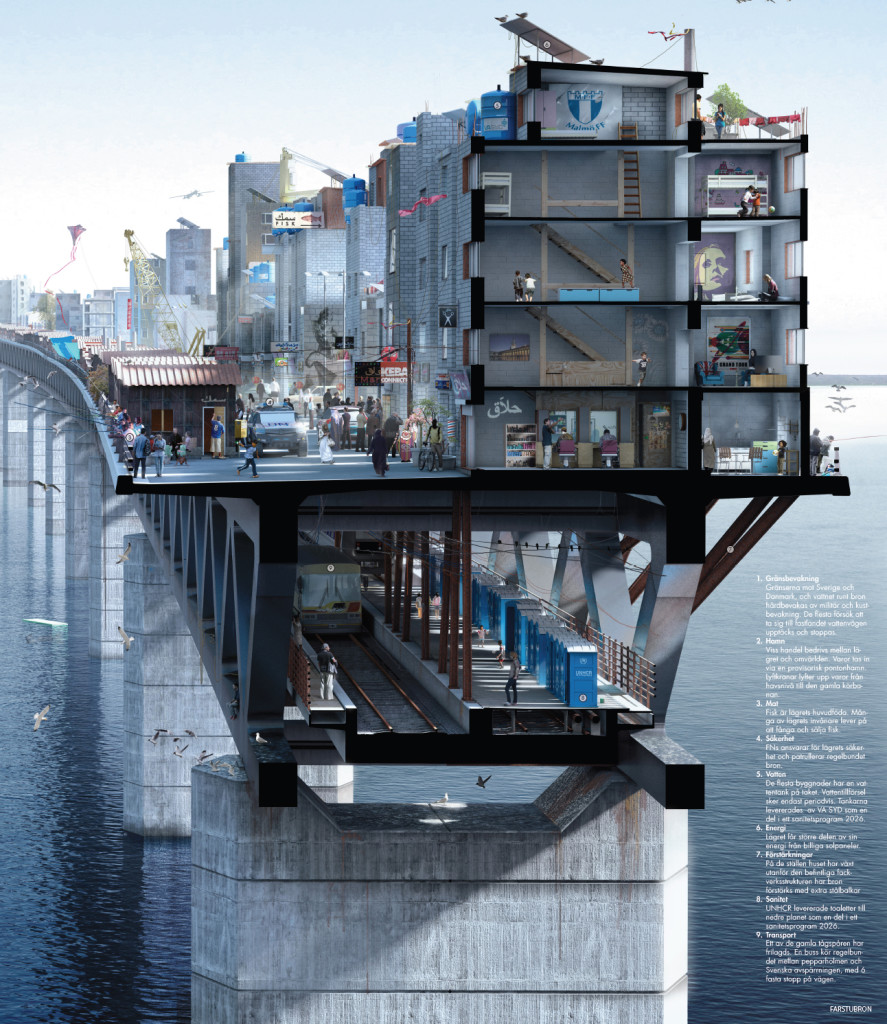This column aims at discovering harbours from a landscape perspective, which means extending our view beyond the delimited harbour area towards the surrounding landscape of which the harbour is a constitutive part – ‘surrounding landscape’ refers to physical landscapes in the first place, but also to landscapes of imagination, such as the ones presented by the winners of the recent Imagine Open Skåne 2030 architecture competition launched by the Swedish Architecture Chamber and the regional government of Scania (in Swedish: Skåne). Scania is Sweden’s southernmost region, linked to Denmark’s easternmost island of Zealand by a bridge over the Öresund straight since 2000, connecting the cities of Malmö and Copenhagen. This bridge is a symbol for cross-border cooperation and the growing together of the binational metropolitan region – a big player in the North, in which transhipment business is a vital part, and where the biggest port authorities merged into Copenhagen Malmö Port in 2004, run as a binational company.
The Öresund bridge, however, has more recently become a symbol for reinforced national borders within what was formerly a borderless Europe. Since the massive arrival of refugees, the Swedish authorities have closed their borders early 2016 and have reinstated passport controls, now an everyday hassle for commuters and immigrants alike, on trains and cars crossing the bridge. Since, the cosmopolitan reality of the Öresund metropolis has turned into fiction again, and the topics of immigration and integration, nationality and identity are heatedly discussed – especially when it comes to think the future of the metropolitan regions of the North, which to a big extent are port cities.
The importance of port cities was confirmed by the Imagine Open Skåne 2030 competition, to which over 60 proposals were submitted. Instead of inward looking ideas about the large expanses of Scanian land, many feature outward oriented visions about the region’s coasts, cities and harbours, the contact zones of Scania with the world around, with global issues like climate change and rising sea levels, like demography and immigration, like infrastructure and urbanisation. The competition initiators argue that architects and designers usually have scant opportunities to influence these broad issues, as they are commonly only engaged at the end of the decision-making processes that drive social development and affect investments into cities and infrastructure: ‘The competition was to turn this process on its head and allow people with creative expertise to highlight forthcoming development by visualizing future environments in the region’, can one read in the jury report published in August 2016.
[one_half_last] [/one_half_last]
[/one_half_last]
All the more interesting are the three port city related proposals among the winning entries. The first prize went to the utopian idea of an artificial archipelago in the Öresund, extending the urban areas of Copenhagen and Malmö into a new European port city, built underneath the Öresund Bridge and complementing it with two more bridges and a metro tunnel. This new urban archipelago alludes to functions and images of New York City, a port city known for having served as the entrance door to the New World for many immigrants from Europe in previous epochs, eventually becoming one of the most populous and densest cities on the North-American continent. The title of this entry, ‘Ge mig era trötta…’ (Give me your tired…), is a quote from an inscription at Statue of Liberty, symbol of welcome in the harbour of New York, and underscores the idea that this new Öresund City is to host up to 5 million new inhabitants, arriving after tyring travels from away destinations. In this proposal, Scania’s future depends on a new kind of port city, inseparable from the world, inseparable from the Swedish and Danish neighbour cities, and impossible for border controls and reinstated national identity.
Both fourth ranked proposals literally lift the spatialized vision of a new cross-border port city society into adventureous altitudes, namely onto the Öresund Bridge as the very symbol of crossborder connection. In both competition entries, the Bridge gets built up into a city high upon the waters of the straight, with its port at the bottom of the two giant pillars that support the bridge’s suspension ropes.
In the tradition of 20th century speculative architecture à la Archigram, the authors of the proposal entitled ‘Grensländet’ (borderland) unfold the utopia of an independent and sustainable new city between the nation states of Denmark and Sweden, between the existing cities of Copenhagen and Malmö. From the bridge platform itself, this utopic city grows upwards into the sky and down towards the water, while mainly hovering in between, relying on an autonomous circular system for energy, food and waste – of course more an image than reality, a built bubble of happiness. Its only point of contact to the world: the port.
The dystopia of a refugee city on top of the Öresund bridge, closed to stop the massive immigration into Sweden, won one of the shared fourth prizes in the Imagine Open Skåne 2030 competition: ‘Farstubron’ (entrance hall bridge), by Björn Bondesson.
On the other hand, the competition entry ‘Farstubron’ (entrance hall bridge) develops a dystopic idea about the built-up Öresund bridge. The authors imagine that the bridge has been closed, under the pressure of ultraright political forces, to stop immigration into Sweden, and that the refugees caught in the camp on the Danish side have managed to highjack and build up the bridge into a spontaneous settlement which grows into an informal city – like the many that constitute the dominant form of urbanization on this planet. This city is not autonomous, and neither is it a desired one. It depends on support by outside organizations, like the UN, who deliver water, sanitation and health serices – via an improvised port.
Port cities have always featured extremes – both landscapes of fear and landscapes of hope. The creative minds involved in the Scanian competition unfold both in front of our eyes to challenge our brains. The dystopian idea of the highjacked bridge with its supporting harbour is particularly evocative and highly instrumental: it prevents us from ousting undesired futures and naively believing in the good course of things; it delivers a frightening idea of a city to come that alerts us when the reality gets dangerously close to this picture.
References
https://www.arkitekt.se/tavling/imagine-open-skane-2030/
Head image: The utopian idea of a new European port city in the Öresund, between Copenhagen and Malmö, won first prize in the Imagine Open Skåne 2030 competition: ‘Ge mig era trötta…’ (Give me your tired…), by Sweco Architects.

